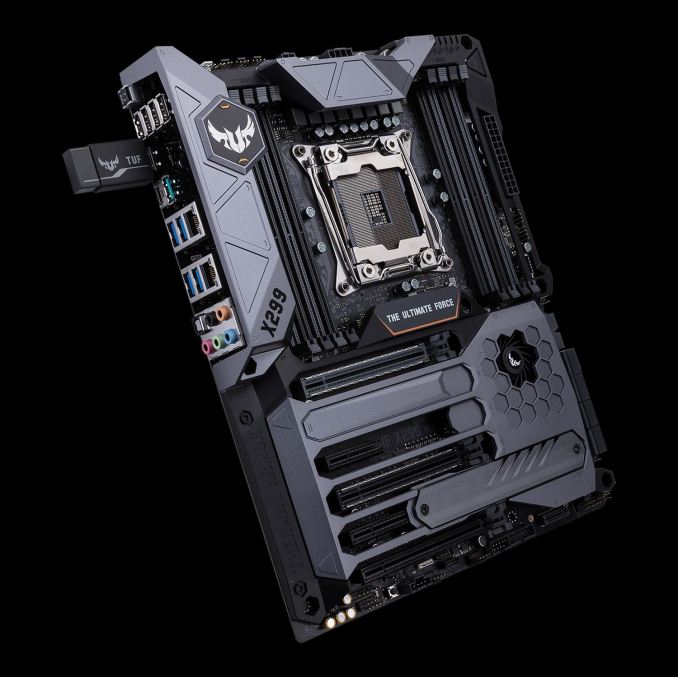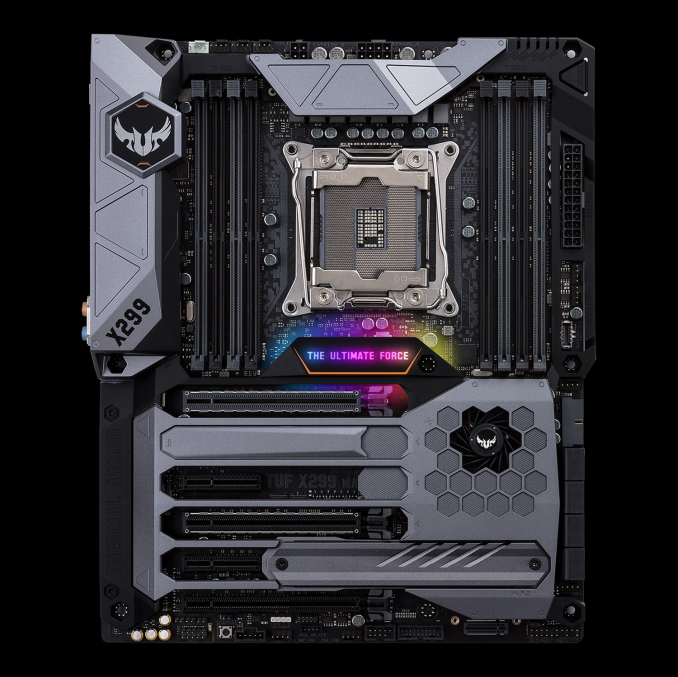The ASUS TUF X299 Mark I Motherboard Review: TUF Refined
by Joe Shields on December 6, 2017 9:30 AM EST- Posted in
- Motherboards
- Asus
- TUF
- X299
- Skylake-X
- Kaby Lake-X
Conclusion
The ASUS TUF X299 is priced at $340 on Amazon which, by price, puts it square in the crosshairs of the EVGA X299 FTW ($330), MSI X299 Gaming Pro Carbon AC ($330), GIGABYTE X299 AORUS Ultra Gaming Pro ($350), and the ASRock X299 Taichi XE ($322).
The TUF line of motherboards are designed to be reliable and durable 24/7 motherboards. The Thermal Armor keeps dust off the board and with the fan, cools the chipset and M.2 device in the slots below it. The back plate not only protects the board from physical damage and improves rigidity, with the thermal pads between it and the back of the VRM, also helps to keep that area cooler as well. Though we did not see issues in our testing, I would have liked not to see the VRM heatsink covered (on any board) with a shroud to help with airflow. Outside of that, the Thermal Armor does look good to me. I'll admit, sometimes its nice not to see the all the little bits on the board. Clearly, that is a subjective opinion, appearance, but the look of the armor has come a long way since it started.
Feature-wise, the TUF X299 Mark 1 has a lot of things going for it. The 8-phase digital VRM is shared with other boards in the lineup (Strix XE, Mark 1, Prime X299-A) and held its own during testing. Overclocking landed just where we expected it to at 4.5 GHz as we are thermally limited with the test system and parameters. The TUF did allow for a slightly lower voltage at the same clocks, but not enough of a difference to increase clocks or lower temperatures. Since we measure via software, the readings aren't as accurate so the difference was truly negligible.
Outside of that, the board gives users the full complement of six SATA ports supported by chipset as well as two M.2 slots. The first sits under the M.2 heatsink and is cooled by the chipset fan, while the second slot is a vertical M.2 slot located just below it. The vertical M.2 slot is a creative use of space and with the supplied mounting, will sit there securely. It does take some geting used to looking at a 4" stick jutting out of your motherboard though! Last, the latest USB 3.1 ports (Type-A and Type-C) are found on the back panel as well as support for a front panel USB 3.1 Type-C.
The TUF Detective 2 software for Android worked fine and showed high-level system information including a section for the debug codes. Users are able to connect to the included Bluetooth dongle and power your system on/off, reboot it, and even clear the CMOS. A useful tool indeed, however, a debug LED would have likely saved a bit of money, accomplishes the same goals, may cost less, and easier to gather information from without having your phone/tablet handy at all times.
If gaming is going to be your primary use the TUF Mark 1 has you setup nicely, specifically in the multi-GPU space. 3-Way SLI/Crossfire is supported with a 28/44-lane CPU, and triple slot spacing helps the oversized heatsinks access to cooler air. The dual Intel network ports also have traffic priortizing software, Turbo LAN, used to adjust traffic for the best online performance of whatever application is selected as a priority.
Overall the ASUS TUF X299 Mark 1 is a sound foundation for the X299 platform with its PCIe slot configuration, dual Intel NICs, two M.2 slots, and eight SATA ports. The TUF Armor helps with both rigidity (back plate) keep dust out off the board, as well as the cooling it provides for the M.2 device and PCH heatsink. The back plate even assists with VRM cooling. Performance in our testing landed where expected for the given clock speeds so nothing is outstanding in that respect. If saving money is a concern, the TUF X299 Mark 1 is a bit less expensive and carries over a lot of the features, but less of the armor/aesthetics. If the TUF Mark 1 meets all your needs, and require a more rugged, protected board, there is no need to shy away from it.












15 Comments
View All Comments
DanNeely - Wednesday, December 6, 2017 - link
Why are you only reporting on non-UEFI post times?takeshi7 - Wednesday, December 6, 2017 - link
TUF motherboards should NOT have any electrolytic caps. The whole reason I bought my TUF motherboard was for the all solid-state caps. Asus please stop with this crap. I don't care about "Nichicon gold" audio capacitors. If I did I would buy one of your other boards like ROG. It doesn't make a big enough difference to justify the shorter lifespan, and anyone who cares about audio will have an external amp/DAC anyways.tphb - Wednesday, December 6, 2017 - link
It looks like a very nice board, but I still don't understand the need for "durable". You're going to put it in a case, right? One that has mounting screws to keep the board straight and one that keeps rocks from randomly flying up to hit the PCI-E mount surround. So why do you need all the extra plastic? It creates heat challenges (that require a fan) for no real benefit.BreakArms - Wednesday, December 6, 2017 - link
The original TUF Sabertooth back with the X58 chipset had a 5 year warranty and their marketing targeted "Military grade" lingo. I built a system for someone because of the long warranty. Today I'm not sure, it's likely that either they've been skimping on the quality and had to reduce their warranty to 3 years to keep from losing too much money or they had to reduce the warranty to 3 years anyway because their previous TUF boards were costing them too much to support.Anyway good job reviewing a board AT, I wish you'd return to regular reviews like this.
Ev3rM0r3 - Wednesday, December 6, 2017 - link
Here in the real world, all that armor on a motherboard is there ONLY for aesthetic reasons. Unless you are mounting it to an open air source but no one is going to do that. It clutters the board and probably adds in a 1/4 of the cost of the entire motherboard. I'd say just include a disk with 3d printable shielding for looks IF I wanted to have it, and then just not put anything on the board. Starting too look like cars with plastic engine covers; those are useless too.Hurr Durr - Wednesday, December 6, 2017 - link
Can these faux-shield things be removed? I doubt having them provides any practical benefit.DanNeely - Wednesday, December 6, 2017 - link
The easiest way is probably an equivalently specced board without them. They're the TUF line's main marketing gimmic.Joe Shields - Friday, December 8, 2017 - link
Yes. But if you do not want them, you can get the less expensive variant without it or a different board.JackNSally - Thursday, December 7, 2017 - link
Honest question. Can you get a higher performance cooler to really push the CPU and therefore the boards VRM's for overclocking features?Joe Shields - Friday, December 8, 2017 - link
The cooler isn't really the issue. We can put this under a custom loop, but the temperature improvement would only yield perhaps another 100 MHz or so. Delidding and going bigger would be a better way to do this.